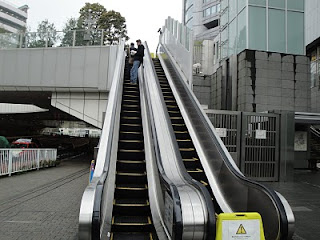An underground entrance, after emerging from the subway.
The plaza in front of Tokyo Midtown.
Another scene in the plaza.
You should get an idea of the pretensions of this place from pictures like this.
One of two such fountains, in which water keeps sliding down over the glass panes.
A shopping corridor.
Looking down from an upper corridor.
At one point, I noticed an outdoor produce market. Tokyo Midtown is known not only for its expansive mall and expensive products, but for a striking museum and beautifully landscaped gardens. To see such an open area of greenery in the midst of such high-priced real estate comes as something of a surprise. The produce market was set up in a u-shape near the gardens, just outside the Galleria shopping area, and each vendor had a small booth selling beautifully arranged produce and other items, including mushrooms, fruit, rice crackers, tomato juice, and so on. I videotaped some of this as I walked through the drizzle, occasionally stopping to taste a free sample of the wares.
Looking out at the produce market from inside the Galleria.
Those guys on the right were waiting for me with a free sample of a big, juicy strawberry.
Schoolgirls crossing the road as I walked to the produce market in the park.
That low-slung building is a museum, but the new exhibition doesn't open until tomorrow.
The landscaping would have looked better if the sun were out.
A view of the office building.
The fruit displayed in Japanese boutique fruit stores is too beautiful to eat. And it's too expensive to buy, except, perhaps as a gift.
Why they call this place Deli beats me. There wasn't a roast beef to be found.
Remember, the Portuguese introduced bread to Japan several hundred years ago. And the Japanese have made it their own.
A classy mall, wouldn't you say?
Specialty fish items. And there was nice line waiting to buy them.
My 18-year-old granddaughter, Briar, is a clothes horse, and is interested in the local fashions, so I made it my business to photograph many of the clothing boutiques and their window displays. She arrives here next month, so I want to give her a preview of what's in store, although she'll more likely do her shopping elsewhere, such as in the hip area known as Harajuku.
Here begins a series of fashionable boutiques.
My favorite shop was this one, specializing in traditional sundries, especially chopsticks.
If you're going to the bathroom at a place, you might as well do it in style. Just be careful you don't press "eject" on the command module. You may end up on the roof.
This beautiful fountain has a continuous circular stream of water descending from above, practically without making any noise.

Escalator to one part of Roppongi Hills.
After going from floor to floor and checking out this consumer paradise--wealthy consumer paradise, that is--I walked over to the Roppongi area's slightly older supercolossal shopping/hotel/office complex, Roppongi Hills, about ten minutes away. Let's see what that walk entailed, or at least part of it.
Before going into the shopping area, I visited an exhibit of great Western paintings at the Mori Art Museum, on loan from the Boston Museum of Fine Arts, on the 52nd floor of the Mori Tower, Tokyo's tallest structure. John Gillespie recommended that I visit it, and it was worth the effort. By the way, in the past, anything like a skyscraper would have been impossible in Tokyo because of the dangers of earthquakes, which are rather common in Tokyo. The city's last major quake was in 1923, and the fires that resulted because of the town's then mostly wooden structures resulted in enormous loss of life and property. Tokyo is overdue for the next big one, so when you look at some of the tall buildings that have gone up locally in recent years, you have to hope that today's architects know what the hell they're doing. The exhibit ranged from the Dutch masters to the Impressionists, and was quite well laid out. A considerable crowd of Japanese visitors was on hand to study these wonderful old pictures.
Once inside the shopping center, I saw that Roppongi Hills was very much like Tokyo Midtown. The architecture was not radically different, and the shops were equally high-toned, but the layout was kind of bizarre. Whereas Tokyo Midtown's stores are situated on straight pathways, those at Roppongi Hills are in more mazelike passageways, and you can easily miss some shops if you don't follow the labyrinth. Here's a brief idea of what it's like in this fabulous emporium. The main shopping area is in the West Walk, but there's an East Walk, too, although it's much less impressive and you can skip it if you don't have time. This video should give you an idea of what it has.
Outside scene at Roppongi Hills.
Mori Tower, tallest structure in Tokyo.
Inside Roppongi Hills shopping area.
Bar and grill on 5th floor of Roppongi Hills.
Next week, I plan to introduce some kabuki-related discussion based on my reading, in addition to things I'm seeing while I'm here. I hope some of you will find it interesting and get an idea of why I'm so fond of this form of traditional Japanese theatre.






































Sam, this mall puts L.A.'s galleria to shame.
ReplyDelete